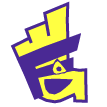 Second International Conference on
Automatic Face and Gesture Recognition '96
Second International Conference on
Automatic Face and Gesture Recognition '96
Oct 13-16, 1996, Killington, Vermont, USA
Panel #3: Better Frameworks for Face and Gesture Recognition
Chair & Moderator: Peter Stucki / University of Zurich
Panelists: TBA
Wednesday October 16, 1996, 10:15am- 11:15noon
Summary
In the field of information technology, new technical developments
occur with enormous rapidity. Yet a fast development phase is most
likely followed by a maturing phase in which the pace of technical
development slows down. This is the time to begin to think and
initiate streamlining activities in order to put forward a coherent
set of process and interface specifications that may lead to an open
system. The fields of face and gesture recognition have now reached
this phase: while a wide range of approaches and implementations are
available as separate entities, their interworking could dramatically
enhance overall applicability [1]. Streamlining and formalizing aim
to define and ensure performance attributes and features of products
and systems, as well as precise methods of testing and measuring their
attributes and features. They can reduce uncertainties and thus foster
the development of a market place for new and emerging technologies
such as face and gesture recognition. In this context, a formalism
may be defined as a specification approved by a recognized body of
experts. It takes the form of a document created with the involvement
and agreement of many interested parties. The harmonization of a
variety of proposals and drafts to define an open system is generally
a long and tedious process and in practice, this task is by far not
trivial. Therefore, it is proposed to first conceive and create a
framework environment in which individual, partial or complete draft
proposals may be implemented and integrated for rapid application
development and testing [2].
Typically, such framework environments build upon architectural
specifications that interlink functional specifications and
definitions. Ideally, frameworks should provide a programming
environment, guarantee portability, hardware and I/O independence, and
allow the rapid prototyping of specific pilot applications. It is
expected that the experience gained and the results obtained will lead
to an open systems prototype that, after a maturing process, may
provide useful inputs for the definition of possible standards at a
later point in time. The purpose of this panel is to discuss the
potential for speci=1Ffying and formalizing specific tasks in the
field of face and gesture recognition at large and to possibly
initiate two discussion forums. The first, called the Face
Recognition Expert Group (FREG), will be chartered to define a
recognition framework architecture and to select and discuss robust
algorithms and procedures for experimentation. The second, called the
Gesture Recognition Expert Group (GREG) will do so for gesture
recognition related aspects.
If successful, expert group findings and recommendations shall be
discussed in a forthcoming workshop on face and gesture recognition.
References:
[1] Proceedings of the International Workshop on Automatic Face- and
Gesture-Recognition, M. Bichsel, Ed., June 26-28, 1995, Zurich,
Switzerland.
[2] Ackermann Ph., Developing Object-Oriented Multimedia Software
Based on the MET++ Application Framework, dpunkt, Heidelberg, 1996
(ISBN3-920993-52-7).
2d
International Conference on Automatic Face- and Gesture-Recognition
,
fg96@media.mit.edu
Last modified: Tue Sep 10 09:52:57 EDT 1996
 Second International Conference on
Automatic Face and Gesture Recognition '96
Second International Conference on
Automatic Face and Gesture Recognition '96